
by joshua2 | Media
The Desert Champagne casket may be the perfect addition to add to your showroom. It is a stunning example of Batesville Casket Company’s unrelenting focus on providing the world’s finest caskets that help families honour the lives of those they love.
This 20-gauge steel casket sits in the middle of Batesville’s price range and offers affordability for families, as well as some of the finer qualities of Batesville’s upper range models.
The inherent strength and corrosion-resistant qualities of steel make it a highly sought after material for families looking for a casket with enduring qualities.
The highest quality carbon steel is used to create Batesville’s Desert Champagne casket and it is painted with a special shaded finish and features unique pin striping, that gives the casket a more refined look.
The Desert Champagne casket has some industry-leading features including:
- Lid locking mechanism plus a one-piece rubber gasket seal
- Continuously welded base
- 5-year limited warranty
- Interior chemically treated to resist rust and corrosion
- Memorial Record™ System
- Living Memorial® Program
Please contact your Ashton account manager or call us on 1300 263 346, if you would like to add this beautiful Batesville casket to your range today.
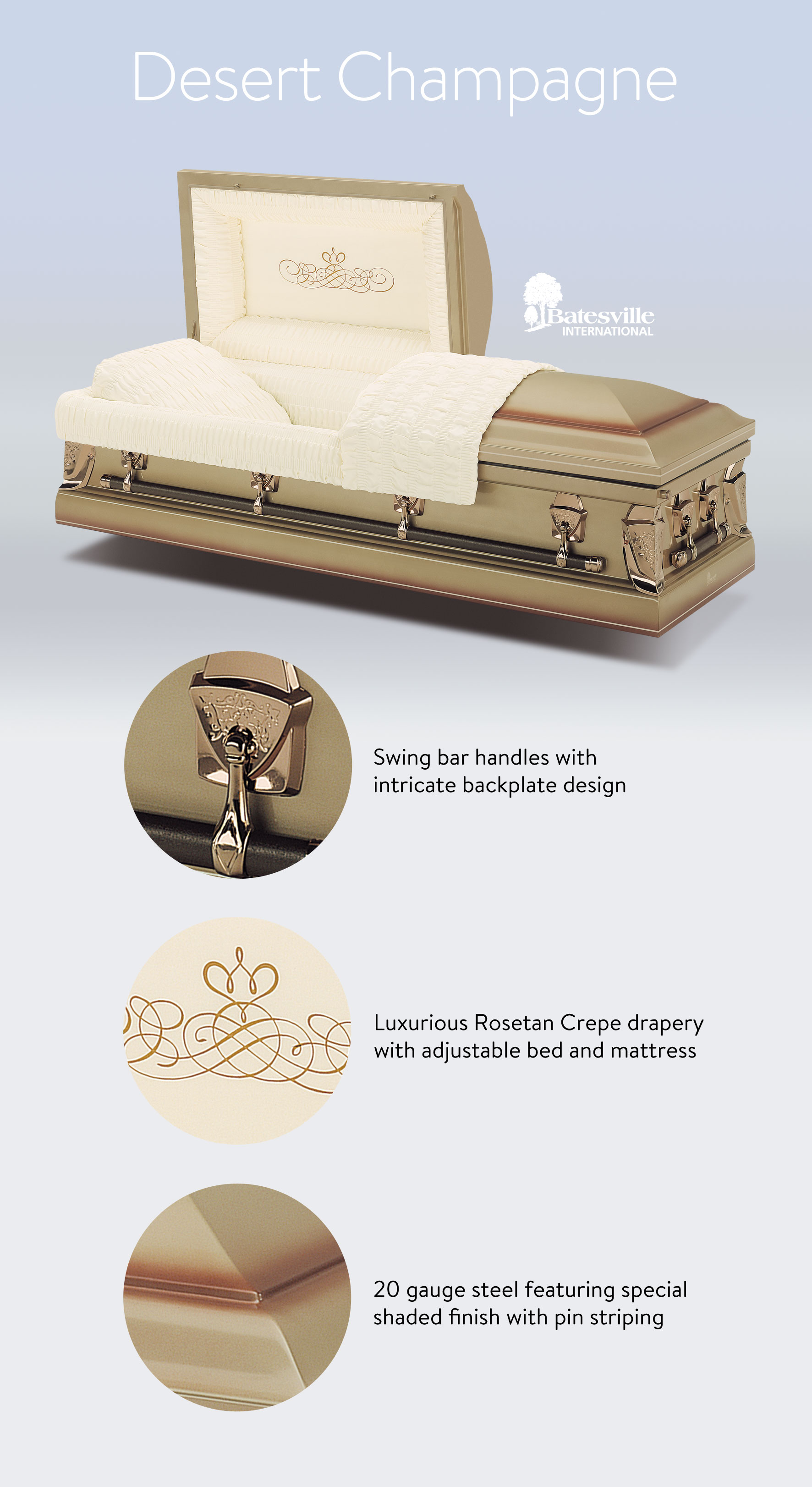

by joshua2 | Media
For over one hundred years, Batesville Casket Company has manufactured the world’s finest caskets. Premium craftsmanship, the highest quality materials and constant innovation have become the hallmarks of Batesville and have helped the company to become the most iconic casket brand in the world.
You would be forgiven therefore, for assuming that all Batesville caskets are available at a premium price. But this is not correct.
You will be surprised to know that there is a selection of Batesville caskets that carries the iconic brand name and qualities but is significantly more affordable than the solid timber, bronze and steel options. This range of Batesville caskets allows more families to be able to choose a Batesville casket for their loved one, at a lower price point.
What’s more, these caskets are all fully crematable and part of Batesville’s trademarked Living Memorial® Program.
The graphic below shows the Brighton, Serenity and Taylor casket options from this range.
Please contact your Ashton account manager for more information on this range or you can download the full Batesville catalogue here.


by joshua2 | Media
Funeral directing is a challenging job: short timelines, grieving families and the pressures of modern business make burnout a real issue for both funeral home owners, management and staff. Burnout may result in staff who are disengaged and demotivated in their job role, which can lead to an obvious reduction in their productivity and performance.
These 5 steps are suggestions that may help to prevent or avoid burnout within your team.
- Ditch multitasking and help employees truly focus
Mutitasking is deeply engrained in our fast-paced business environments. Based on over 50 years of cognitive science, and more recent studies, we know that multitasking is inefficient and does not work.
The fractured attention span caused by frequent multitasking can be seriously impacting productivity and morale. Paul Atchley is an associate professor of Cognitive Psychology at the University of Kansas and reports that multitasking makes us less effective in our jobs and our lives, and can affect our long-term memory and creativity.
Some employees are asked to split their attention between a myriad of tasks on a daily basis, which can mean that almost nothing actually receives full attention.
The solution may be monotasking.
Monotasking is focussing on a single task at hand instead of taking on large to-do lists or projects all at once. And it may be the obvious remedy to a team’s declining motivation and apparent inability to focus.
A 2016 University of California study found that people who work online all day are more likely to expend their brain’s natural capacity for focus due to the tendency to multitask. Once employees get to this stage, they may have trouble feeling engaged or motivated, which can lead to burnout.
So how can managers encourage monotasking within their teams? Start by creating concise schedules that help employees balance multiple jobs at once without constantly switching back and forth.
There are always tight funeral timelines to consider, but your team may actually be more productive and engaged if you can cultivate an environment that helps them work without constantly swapping tasks.
- Discuss career growth on a regular basis
Research by ProOpinion shows that to feel truly valued within an organisation, employees need the opportunity and support to better themselves and advance their careers. 26% of workers feel that career advancement opportunities drive them the most at the office. Without career growth, everyday tasks may lose their purpose, and employees may feel like their work is merely laborious.
Reviews of more than 250,000 large companies in the U.S. showed that opportunities for career advancement was a leading contributor to employee morale.
More frequent discussions relating to career advancement and long-term goals, will lead to employees feeling better supported in their career paths. Simply discussing where employees want to be in the future can have a major impact on how valued people feel, and can help bring a real sense of purpose to their work.
- Encourage recharge periods
Like our smartphones, humans need to be recharged too.
It’s just not in our nature to be constantly tuned in, and when we try to undertake a significant load of work at once, without stopping for periodic breaks, we can actually end up in an unproductive and undesirable state of what researchers call continuous partial attention.
As Linda Stone, the former head of Microsoft University, writes on her website, “In a 24/7, always-on world, continuous partial attention used as our dominant attention mode contributes to a feeling of overwhelm, over-stimulation and to a sense of being unfulfilled. We are so accessible, we’re inaccessible.”
Managers can help by subscribing to a more results-oriented culture in the workplace, which recognises that gaps or breaks in productivity are necessary and healthy.
- Don’t overlook small victories
Research from the University of Michigan found that teams performed best when managers gave 6 times as much positive feedback as negative feedback. When employees received significantly more positive feedback for their work, they were more likely to feel valued, appreciated, and motivated to improve their performance… and these aspects are all key in reducing burnout.
It is common for managers to point out only negative feedback or withhold feedback completely, than to offer employees praise for their work. Alexander Kjerulf, a Denmark-based workplace happiness researcher suggests that criticism is vitally important.
He goes on to say that, “We need to tell people what they do well and what they can do better, but many workplaces either give no feedback or only give criticism. This is a shame because we learn so much from being told what we get right.”
Managers should therefore work hard to bring attention to everyday victories and to let their employees know their work isn’t going unnoticed.
- Set a positive example with your own behaviour
According to a report by the Harvard Business Review, stress can be contagious and easily spread through a business. However, the converse can be true as well. A Gallup report suggests that when any member of a team experiences wellbeing, the effect seems to spread across the entire team.
Managers are in a position to set the tone for their team, by exemplifying positive behaviours in their own day-to-day work and interactions. If you slog away at your computer for 12 hours a day and never take a break, your team members will see this as an example of what to strive for, and mirror your own unhealthy behaviour.
Experts suggest that you check-in with yourself regularly to make sure that you are leading by example. If you’re feeling burnt out, chances are your team is feeling the same as well, and it may be time to implement changes.
Disclaimer: The information contained in this article is general in nature and provided as reference material only. Medical advice should always be obtained from a qualified medical practitioner.
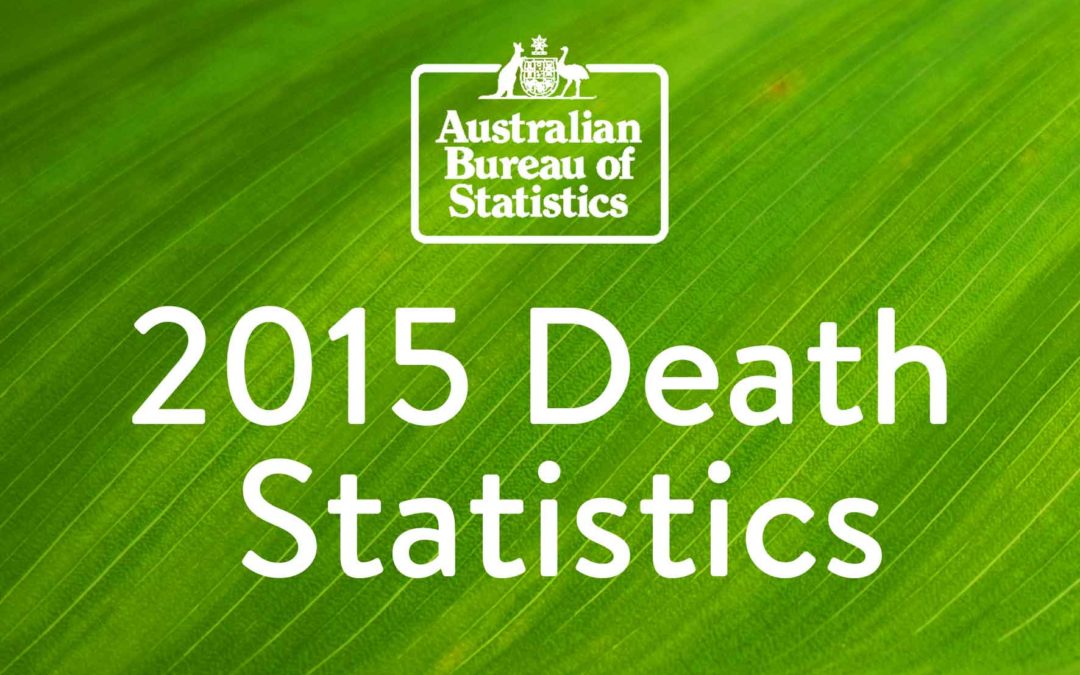
by joshua2 | Media
In September, the Australian Bureau of Statistics released its death statistics for 2015. The ABS usually release these statistics in November each year, for the previous calendar years’ statistics, however, their data is available earlier this year. We present some of their key findings below.

Deaths 2015
There were 159,052 deaths registered in Australia in 2015, 5,472 more than the number registered in 2014 (153,580). Over three quarters (77.5%) of these deaths were to usual residents of New South Wales, Victoria and Queensland. Since 2005, the number of deaths registered has increased by around 1.9% per year on average for males and 2.0% per year for females, with year-to-year fluctuations (see graph 1.1).
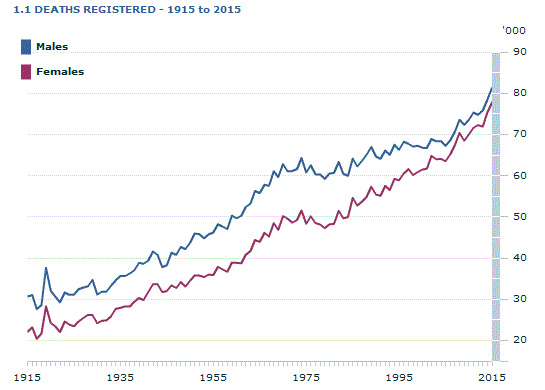
Median age
In 2015, the median age at death was 78.7 years for males and 85.0 years for females. This was an increase of 0.2 years each for both males and females since 2014. Over the past 10 years, the median age at death has increased by 1.9 years for males and 2.1 years for females at the national level. In 2015, the highest median age at death for males was in Victoria (79.8 years) and for females in South Australia (85.7 years). The lowest medians were in the Northern Territory (63.1 years and 63.7 years respectively).
Crude death rates
In 2015, the crude death rate (CDR) in Australia rose to 6.7 deaths per 1,000 population, up from 6.5 in 2005. During 2005 to 2015, the CDRs has been relatively stable with the highest rate at 6.8 deaths per 1,000 population in 2008 and the lowest at 6.4 in 2013.
Standardised death rates
During 2005 to 2015, the standardised death rate (SDR) for Australia showed an overall decline, while experiencing some small fluctuations. SDRs remained unchanged at 5.5 deaths per 1,000 standard population in 2014 and 2015 but down from 6.1 in 2005. The SDRs for males and females also showed an overall decline during the period, again with some small fluctuations (see graph 1.3).

States and territories
In 2015, the Northern Territory had the highest SDR (8.0 deaths per 1,000 standard population). Tasmania recorded the second highest SDR (6.4). The Australian Capital Territory had the lowest SDR (4.8).
Over the past 10 years, SDRs declined in all states and territories. The Northern Territory and the Australian Capital Territory experienced the largest declines (falling by 1.3 and 0.9 deaths per 1,000 standard population respectively). These declines were followed by South Australia (falling 0.7), New South Wales, Victoria and Western Australia (each falling 0.6), and Queensland and Tasmania (each falling 0.5) (see graph 1.4).
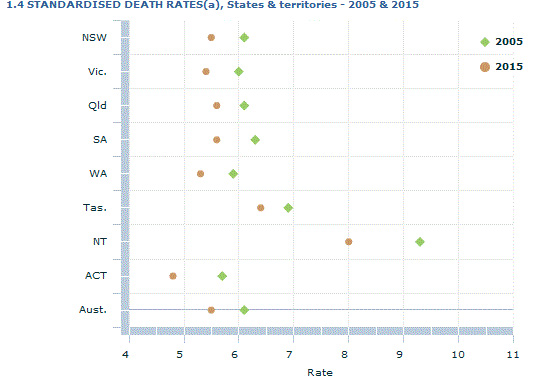
For more information visit the Australian Bureau of Statistics website www.abs.gov.au. You can also download spreadsheets of the ABS’s 2015 death statistics from our Resources section on the website.
![A simple guide to writing a memorable speech [infographic]](https://ashtonmanufacturing.com.au/wp-content/uploads/Website-Media-Resources-image-3-1080x675.jpg)
by joshua2 | Media
Funeral directors are often called upon to speak in front of an audience and to make speeches at local businesses or events. We all want our speeches to have impact and be memorable and the infographic at the end of this article can help you to leave a lasting impression at your next speaking engagement.
We all know what an ‘average’ speech sounds like. We have seen many, maybe hundreds of them over our lifetimes. They’re good, and they’re useful, but they’re not awe-inspiring.
Conversely, we all know what an amazing speech sounds like. They are absorbing, captivating, and inspire action. These type of speeches grab our attention from the very start and leave us with something memorable by the end.
While a lot of credit should go to a person’s speechmaking skills, there are elements of great and memorable speeches that we can adapt into our own speeches.
Website papersmaster.com has put together the infographic below to help create a truly memorable and persuasive speech. It explains the elements of a great topic, how to structure a speech to achieve the best response, how to construct the body to support a claim, how to prepare to give a speech, and tips for a successful delivery.
![A Simple Guide to Writing a Memorable Speech [infographic]](https://ashtonmanufacturing.com.au/wp-content/uploads/speech-writing-infographic.jpg)

by joshua2 | Media
Return to Sender are New Zealand’s leading designers and manufacturers of contemporary coffins, catering to the growing number of people looking for more contemporary, aesthetically designed coffins with an environmental focus.
Return to Sender’s award-winning coffins are designed to ensure families are able to express what was important to their loved one through their coffin choice and are now available in Australia exclusively through Ashtons.
The Wayfarer is an outstanding example of Return to Sender coffin design and has the following features:
- A lightweight modern coffin design
- Constructed from laser-cut plywood from sustainably harvested forests
- Beautiful real leather handles and lid fixings
- Ultra-lightweight but very strong
- A minimal elegant form
- Australian wool fleece mattress & pillow
- Part of Ashton’s Memorial Tree Program
- Internal dimensions L x W x D (cm): 191 x 56 x 29
The Optional extras that are available for the Wayfarer include:
- Bamboo blanket
- Nameplate
- Crucifix
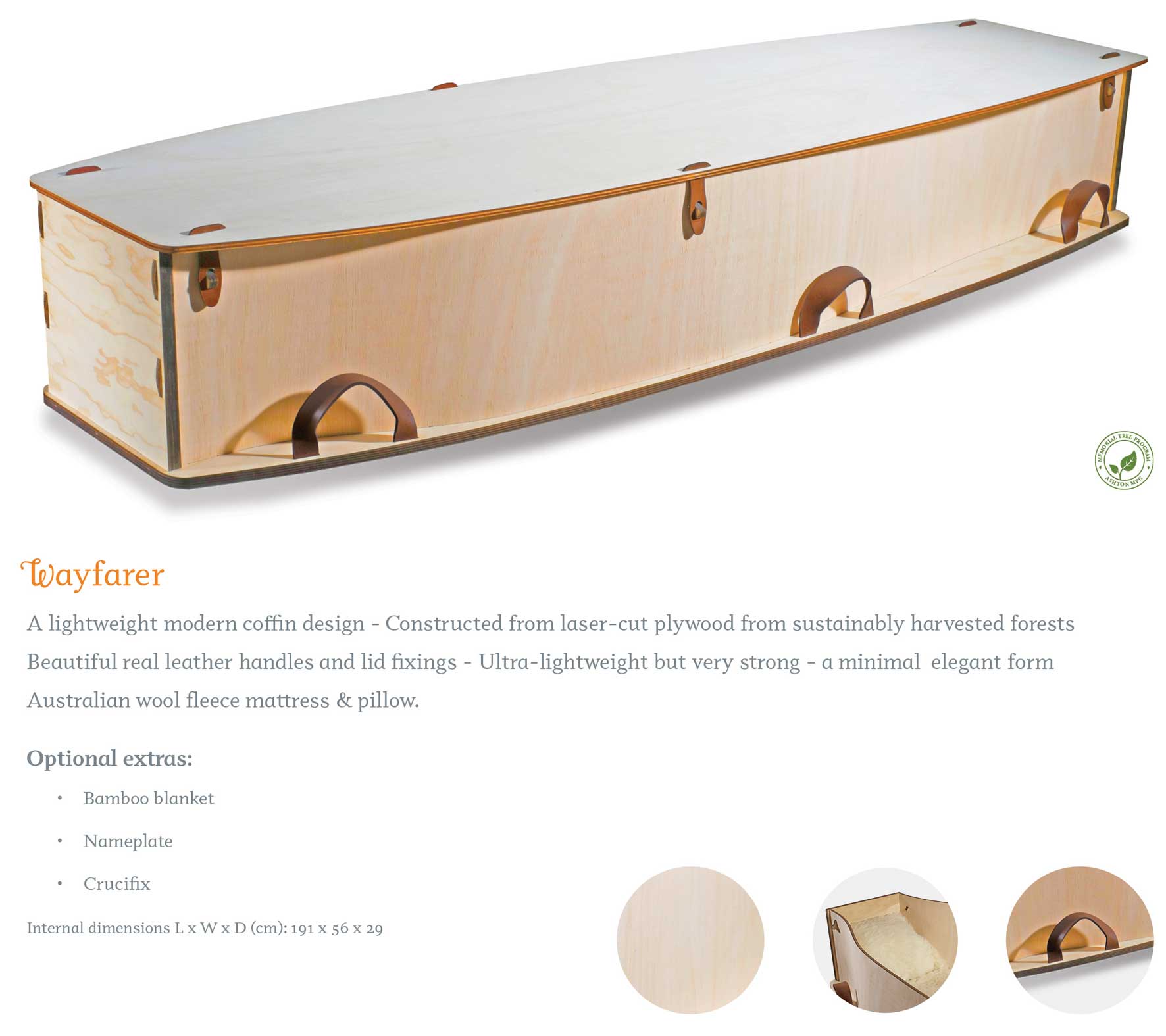












![A simple guide to writing a memorable speech [infographic]](https://ashtonmanufacturing.com.au/wp-content/uploads/Website-Media-Resources-image-3-1080x675.jpg)
![A Simple Guide to Writing a Memorable Speech [infographic]](https://ashtonmanufacturing.com.au/wp-content/uploads/speech-writing-infographic.jpg)


